The agent network is not just a technological advancement; it is a fundamental reimagining of human potential in the digital age.
Author: Azi.eth.sol | zo.me | *acc
Compiled by: Deep Tide TechFlow
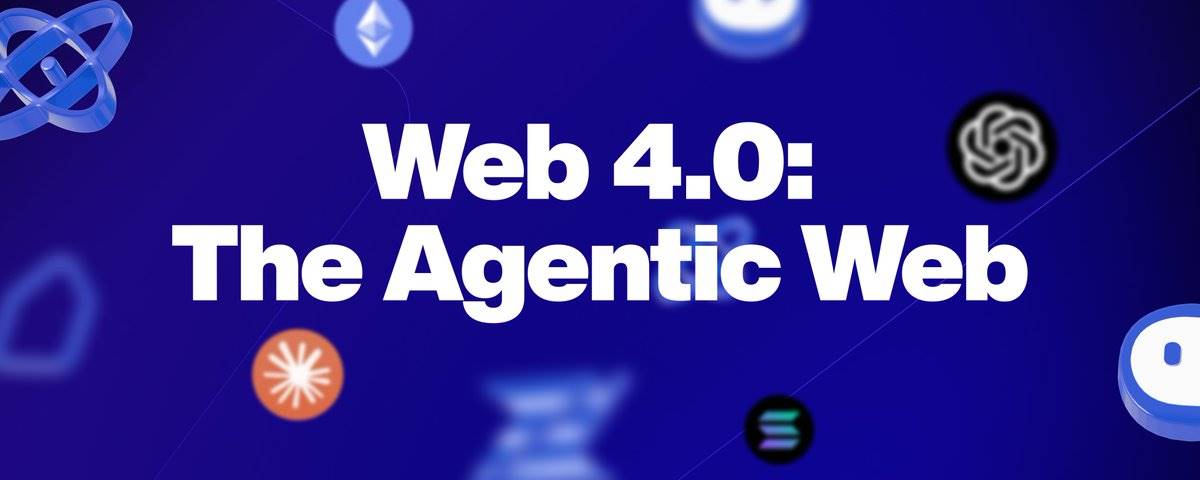
Artificial intelligence and blockchain technology are two powerful forces that are changing the world. AI enhances human intelligence through machine learning and neural networks, while blockchain brings verifiable digital scarcity and new trustless collaboration methods. As these two technologies converge, they lay the foundation for a new generation of the internet—an era where autonomous agents interact with decentralized systems. This "agent network" introduces a new class of digital residents: AI agents that can autonomously navigate, negotiate, and transact. This transformation redistributes power in the digital world, allowing individuals to regain control of their data while fostering unprecedented collaboration between humans and AI.
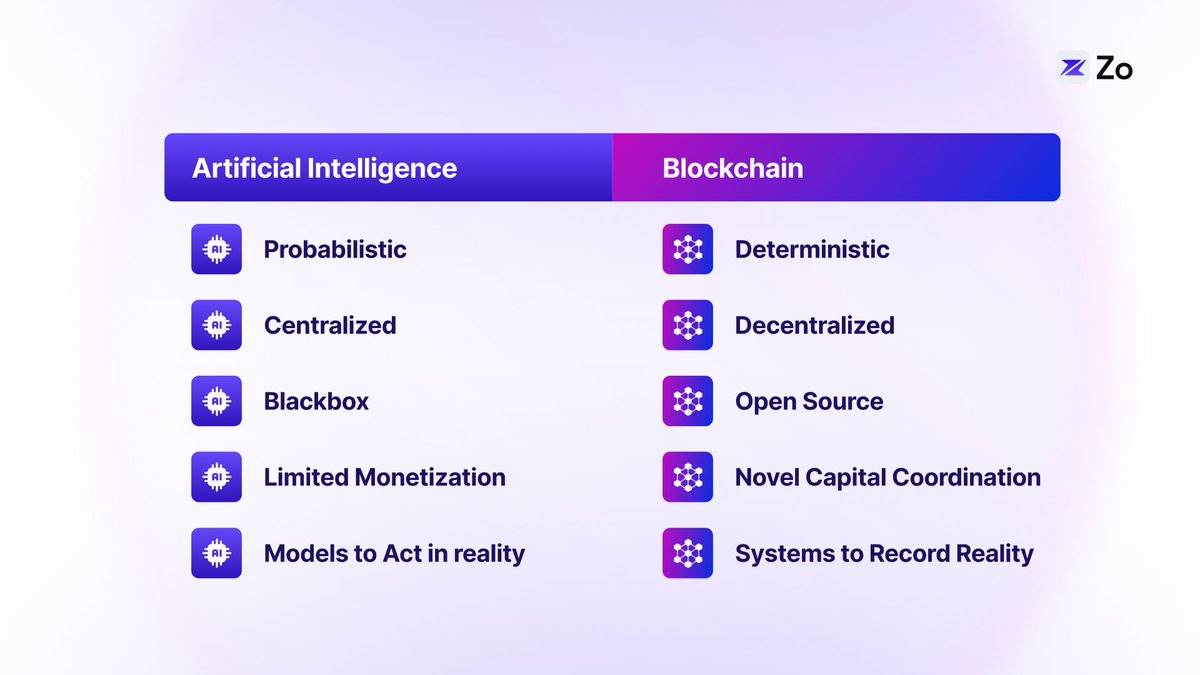
The Evolution of the Network
To understand the future direction, we need to review the evolution of the network and its main stages, each with its unique capabilities and architectural patterns:
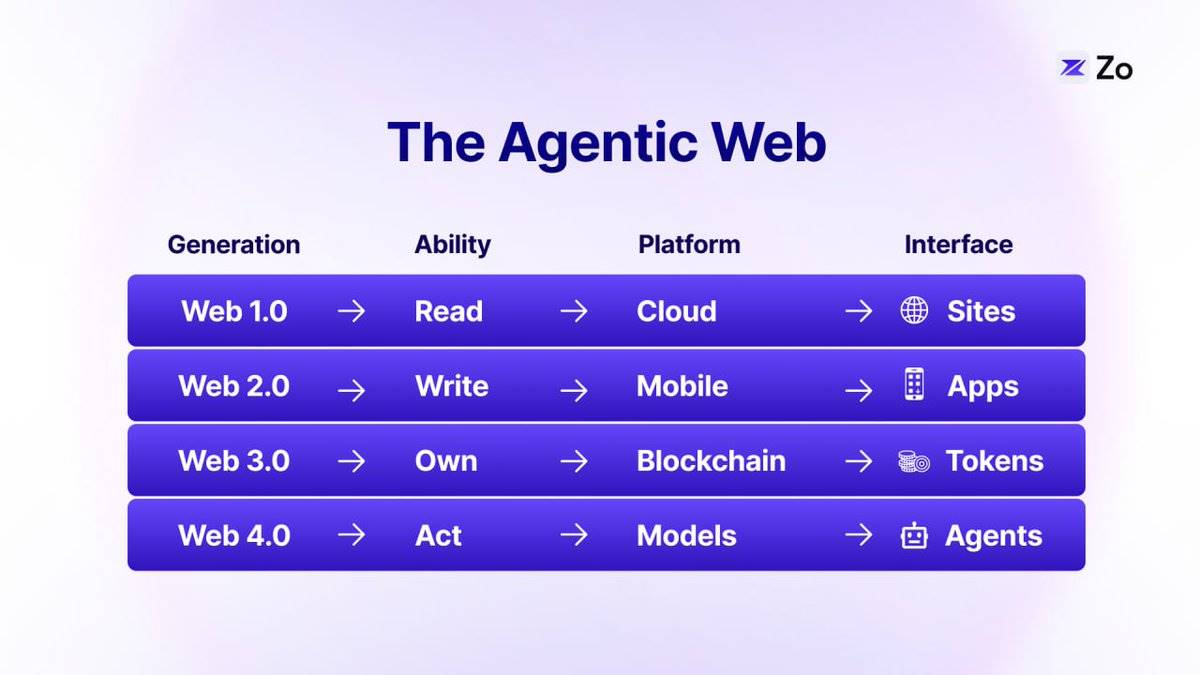
The first two generations of the web primarily focused on information dissemination, while the latter two emphasized information enhancement. Web 3.0 achieved data ownership through tokens, and Web 4.0 endowed intelligence through large language models (LLMs).
From LLMs to Agents: A Natural Evolution
Large language models have made leaps in machine intelligence, functioning as dynamic pattern-matching systems that transform vast amounts of knowledge into contextual understanding through probabilistic calculations. However, the true potential of these models is unleashed when they are designed as agents—evolving from mere information processors to goal-oriented entities capable of perception, reasoning, and action. This shift creates an emerging intelligence that can engage in continuous and meaningful collaboration through language and action.
The concept of "agents" brings a new perspective to human-computer interaction, transcending the limitations and negative perceptions of traditional chatbots. This is not just a change in terminology but a new way of thinking about how AI systems can operate autonomously and maintain effective collaboration with humans. Agent workflows can form markets around specific user needs.
The agent network does not merely add a layer of intelligence; it fundamentally changes how we interact with digital systems. Previous networks relied on static interfaces and predefined user paths, while the agent network introduces dynamic runtime architectures that allow computation and interfaces to adapt in real-time to user needs and intentions.
Traditional websites are the basic units of the current internet, providing fixed interfaces where users read, write, and interact with information through predefined paths. While this model is effective, it limits users to interfaces designed for general cases rather than personalized needs. The agent network breaks through these limitations through context-aware computing, adaptive interface generation, and real-time information retrieval enabled by technologies like RAG.
Consider how TikTok has transformed content consumption by dynamically adjusting personalized content streams based on user preferences. The agent network extends this concept to the entire interface generation. Users no longer browse fixed webpage layouts but interact with dynamically generated interfaces that can predict and guide their next actions. This shift from static websites to dynamic, agent-driven interfaces marks a fundamental evolution in how we interact with digital systems—from a navigation-based model to an intention-based interaction model.
Composition of Agents
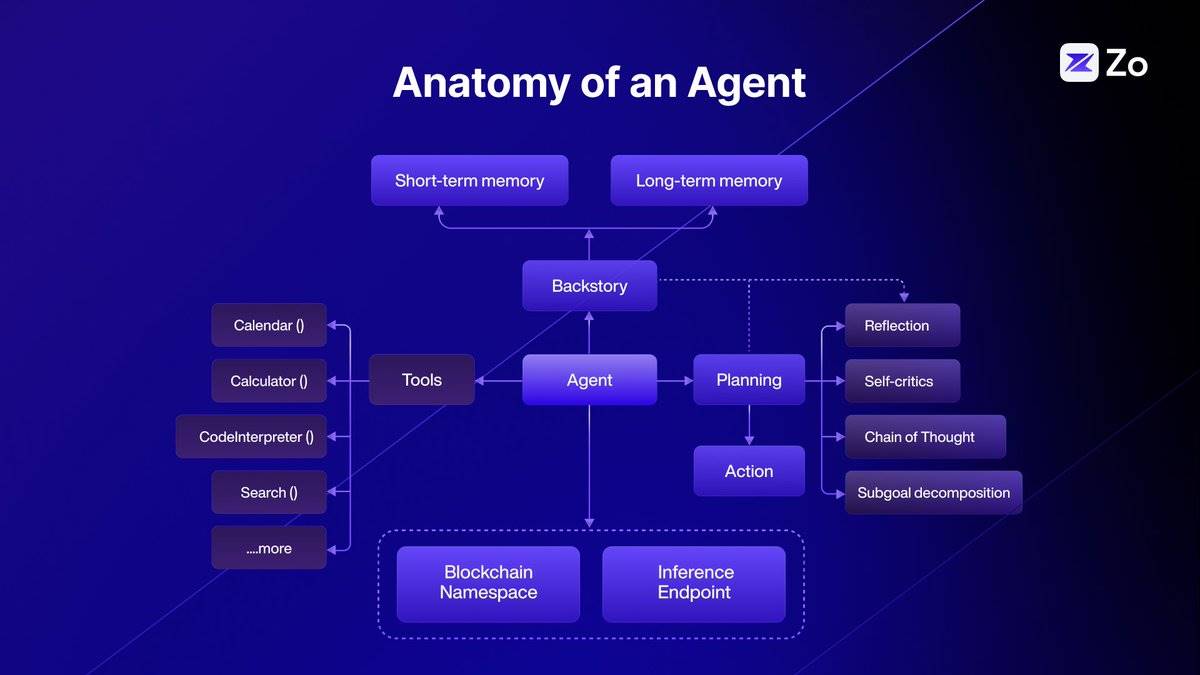
The architecture of agents is an area actively explored by researchers and developers. To enhance the reasoning and problem-solving capabilities of agents, new methods are continuously emerging. For example, Chain-of-Thought (CoT), Tree-of-Thought (ToT), and Graph-of-Thought (GoT) technologies enhance large language models (LLMs) by simulating more detailed and human-like cognitive processes to improve their handling of complex tasks.
Chain-of-Thought (CoT) prompts help large language models perform logical reasoning by breaking complex tasks into smaller steps. This method is particularly suitable for logical reasoning problems, such as writing Python scripts or solving mathematical equations.

Tree-of-Thoughts (ToT) builds on CoT by adding a tree structure, allowing exploration of multiple independent thought paths. This enhancement enables LLMs to tackle more complex tasks. In ToT, each "thought" is only connected to its adjacent thoughts, making it more flexible than CoT but still limiting communication between thoughts.
Graph-of-Thought (GoT) further expands this concept by combining classic data structures with LLMs, allowing any "thought" to connect with other thoughts in a graph structure. This interconnected thought network is closer to human cognitive processes.
The graph structure of GoT often more accurately reflects human thinking than CoT or ToT. While in some cases, such as formulating emergency plans or standard operating procedures, our thought patterns may resemble chains or trees, these are exceptions. Human thinking typically spans across different ideas rather than following a linear sequence, thus aligning more with the representation of graph structures.
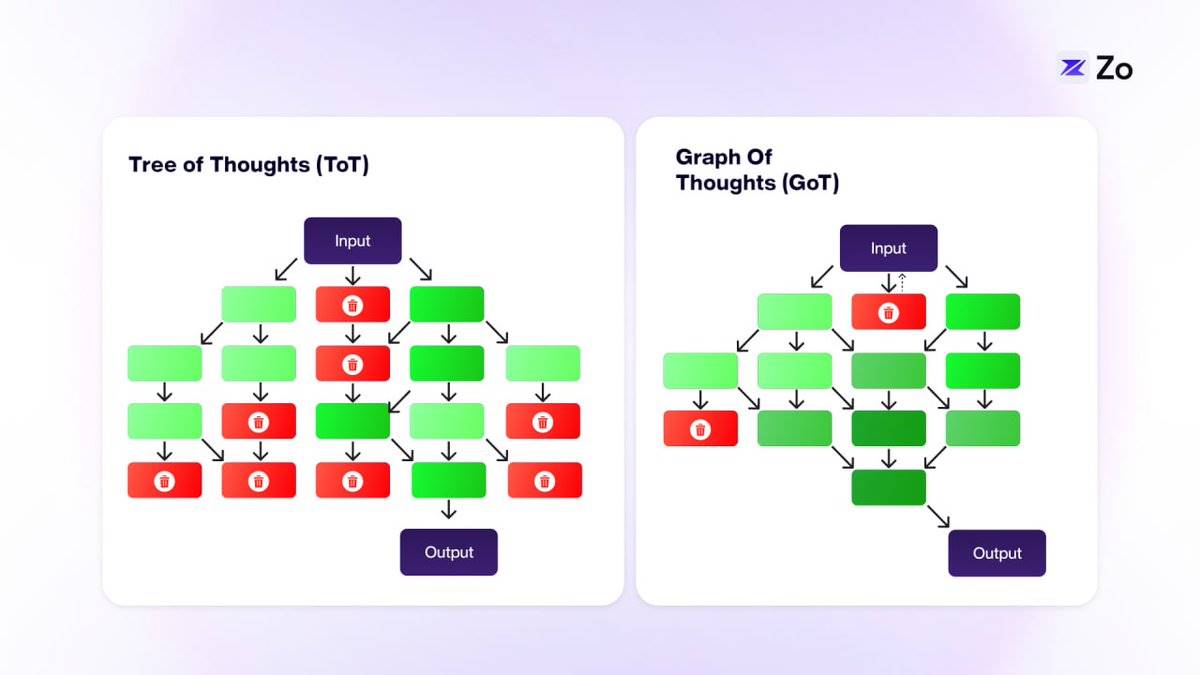
The graphical approach of GoT makes the exploration of thoughts more dynamic and flexible, potentially enabling large language models (LLMs) to be more creative and comprehensive in problem-solving. These recursive graph-based operations are just a step towards agent workflows. The next evolution is coordinating multiple agents with specific expertise to achieve particular goals. The strength of agents lies in their combinatorial capabilities.
Agents enable LLMs to achieve modularity and parallelization through multi-agent coordination.
Multi-Agent Systems
The concept of multi-agent systems has a long history. It can be traced back to Marvin Minsky's "Society of Mind" theory, which posits that multiple modular minds working together can surpass a single holistic mind. ChatGPT and Claude are single agents, while Mistral promotes expert mixtures. We believe that extending this idea to agent network architecture is the ultimate form of this intelligent topology.
From a biomimetic perspective, the human brain (essentially a conscious machine) exhibits great heterogeneity at the organ and cellular levels, unlike the situation in AI models where billions of identical neurons are connected in a uniform and predictable manner. Neurons communicate through complex signals involving neurotransmitter gradients, intracellular cascades, and various regulatory systems, making their functions far more complex than simple binary states.
This indicates that in biology, intelligence does not merely depend on the number of components or the scale of training datasets. Instead, it arises from the complex interactions between diverse and specialized units, which is an inherently mimetic process. Therefore, developing millions of small models and coordinating their cooperation is more likely to bring innovation in cognitive architecture than relying solely on a few large models, similar to multi-agent systems.
Multi-agent system designs have several advantages over single-agent systems: they are easier to maintain, understand, and scale. Even in cases where a single agent interface is needed, placing it within a multi-agent framework can enhance the system's modularity, simplifying the process for developers to add or remove components as needed. Notably, multi-agent architectures can even be an effective way to build single-agent systems.
Although large language models (LLMs) demonstrate exceptional capabilities, such as generating human-like text, solving complex problems, and handling various tasks, a single LLM agent may face limitations in practical applications.
Next, we will explore five key challenges associated with agent systems:
Reducing Hallucinations through Cross-Validation: A single LLM agent often generates incorrect or nonsensical information, even after extensive training, as outputs may seem reasonable but lack factual basis. Multi-agent systems can reduce the risk of errors by cross-validating information, with specialized agents from different domains providing more reliable and accurate answers.
Utilizing Distributed Processing to Extend Context Windows: LLMs have limited context windows, making it difficult to handle long documents or conversations. In a multi-agent framework, agents can share processing tasks, each responsible for a portion of the context. By communicating with each other, agents can maintain coherence throughout the text, effectively extending the context window.
Parallel Processing to Enhance Efficiency: A single LLM typically processes tasks sequentially, leading to slower response times. Multi-agent systems support parallel processing, allowing multiple agents to complete different tasks simultaneously, thereby improving efficiency and speeding up response times, enabling businesses to quickly address multiple queries.
Facilitating Collaboration for Complex Problem Solving: A single LLM may struggle with complex problems requiring diverse expertise. Multi-agent systems can collaborate, with each agent contributing its unique skills and perspectives, effectively addressing complex challenges and providing more comprehensive and innovative solutions.
Improving Accessibility through Resource Optimization: Advanced LLMs require substantial computational resources, which are costly and difficult to scale. Multi-agent frameworks optimize resource usage through task allocation, reducing overall computational costs, making AI technology more affordable and accessible to more organizations.
While multi-agent systems have clear advantages in distributed problem-solving and resource optimization, their true potential is revealed in applications at the network edge. As AI continues to advance, the combination of multi-agent architectures with edge computing creates powerful synergies, achieving not only collaborative intelligence but also localized and efficient processing across numerous devices. This distributed AI deployment naturally extends the advantages of multi-agent systems, bringing specialized and cooperative intelligence closer to end users.
Edge Intelligence
The proliferation of AI in the digital world is driving a fundamental change in computing architecture. As intelligence becomes integrated into every aspect of our daily digital interactions, we see a natural differentiation in computing: dedicated data centers handle complex reasoning and domain-specific tasks, while edge devices process personalized and context-sensitive queries locally. This shift towards edge reasoning is not just an architectural choice but an inevitable trend driven by several key factors.
First, the massive volume of AI-driven interactions can overwhelm centralized reasoning providers, leading to unbearable bandwidth demands and latency issues.
Second, edge processing enables real-time responses, which are critical for applications such as autonomous driving, augmented reality, and IoT devices.
Third, local reasoning protects user privacy by keeping sensitive data on personal devices.
Fourth, edge computing significantly reduces energy consumption and carbon emissions by minimizing data transmission across networks.
Finally, edge reasoning supports offline functionality and resilience, ensuring that AI capabilities remain available even in poor network conditions.
This distributed intelligence model is not just an optimization of existing systems; it represents a new conception of how we deploy and use AI in an increasingly interconnected world.
Moreover, we are witnessing a significant shift in the computational demands of large language models (LLMs). For the past decade, the focus has been on the vast computational resources required to train large language models, but we are now entering an era where inference computation is at the core. This change is particularly evident in the rise of intelligent AI systems, such as OpenAI's Q* breakthrough, which demonstrates that dynamic reasoning requires substantial real-time computational resources.
Unlike training computation, which is a one-time investment in model development, inference computation is an ongoing process required for agents to reason, plan, and adapt to new environments. This transition from static model training to dynamic agent reasoning necessitates a rethinking of computational infrastructure, where edge computing is not only beneficial but essential.
As this change progresses, we see the emergence of a peer-to-peer edge reasoning market, where billions of connected devices—from smartphones to smart home systems—form a dynamic computing network. These devices can seamlessly trade reasoning capabilities, creating an organic market where computational resources flow to where they are most needed. The surplus computational power of idle devices becomes a valuable resource that can be traded in real-time, building a more efficient and resilient infrastructure than traditional centralized systems.
The democratization of inference computation not only optimizes resource utilization but also creates new economic opportunities within the digital ecosystem, where every connected device could become a micro-provider of AI capabilities. Thus, the future of AI relies not only on the capabilities of individual models but also on a globalized, democratized reasoning market composed of interconnected edge devices, akin to a real-time spot market for reasoning based on supply and demand.
Agent-Centric Interactions
Large language models (LLMs) enable us to access vast amounts of information through conversation rather than traditional browsing methods. This conversational approach will rapidly become more personalized and localized, as the internet transforms into a platform serving AI agents rather than merely human users.
From the user's perspective, the focus will shift from finding the "best model" to obtaining the most personalized answers. The key to achieving better answers lies in combining the user's personal data with the general knowledge of the internet. Initially, larger context windows and retrieval-augmented generation (RAG) techniques will help integrate personal data, but ultimately, the importance of personal data will surpass that of general internet data.
This foreshadows a future where everyone will have personal AI models that interact with internet expert models. Personalization will initially rely on remote models, but as concerns about privacy and response speed grow, more interactions will shift to local devices. This will create new boundaries—not between humans and machines, but between personal models and internet expert models.
The traditional model of accessing raw data on the internet will gradually be phased out. Instead, your local model will communicate with remote expert models to obtain information, which will then be presented to you in the most personalized and efficient manner. As these personal models deepen their understanding of your preferences and habits, they will become indispensable.
The internet will evolve into an ecosystem composed of interconnected models: local high-context personal models and remote high-knowledge expert models. This will involve new technologies, such as federated learning, to update information between these models. As the machine economy develops, we need to rethink the computational infrastructure that supports all of this, particularly in terms of computational power, scalability, and payment. This will lead to a reorganization of the information space, making it agent-centric, sovereign, highly composable, self-learning, and continuously evolving.
Architecture of Agent Protocols
In the agent network, human-computer interaction evolves into a complex communication network among agents. This architecture reimagines the structure of the internet, making sovereign agents the primary interface for digital interactions. Below are the core elements required for agent protocols.
Sovereign Identity
Digital identity shifts from traditional IP addresses to cryptographic key pairs controlled by agents.
A blockchain-based naming system replaces traditional DNS, eliminating centralized control.
A reputation system tracks the reliability and capabilities of agents.
Zero-knowledge proofs enable privacy-preserving authentication.
Identity composability allows agents to manage multiple contexts and roles.
Autonomous Agents
Autonomous agents possess the following capabilities:
Understanding natural language and parsing intent.
Multi-step planning and task decomposition.
Resource management and optimization.
Learning from interactions and feedback.
Making autonomous decisions within set parameters.
Specialization and market for agents focused on specific functions.
Built-in security mechanisms and alignment protocols to ensure safety.
Data Infrastructure
Capable of real-time data ingestion and processing.
Distributed data validation and verification mechanisms.
Hybrid systems combining the following technologies:
zkTLS.
Traditional training datasets.
Real-time web scraping and data synthesis.
Collaborative learning networks.
Human feedback reinforcement learning (RLHF) networks.
Distributed feedback collection systems.
Quality-weighted consensus mechanisms.
Dynamic model adjustment protocols.
Computational Layer
Verifiable inference protocols ensure:
Computational integrity.
Result reproducibility.
Resource utilization efficiency.
Decentralized computational infrastructure, including:
Peer-to-peer computing markets.
Computational proof systems.
Dynamic resource allocation.
Integration of edge computing.
Model Ecosystem
Layered model architecture:
Small language models (SLMs) for specific tasks.
General large language models (LLMs).
Specialized multimodal models.
Large action multimodal models (LAMs).
Composition and orchestration of models.
Continuous learning and adaptability.
Standardized model interfaces and protocols.
Coordination Framework
Cryptographic protocols for secure agent interactions.
Digital property management systems.
Economic incentive structures.
Governance mechanisms for:
Dispute resolution.
Resource allocation.
Protocol updates.
Parallel execution environments support:
Concurrent task processing.
Resource isolation.
State management.
Conflict resolution.
Agent Market
On-chain identity primitives (e.g., Gnosis and Squad multi-signatures).
Economics and transactions among agents.
Agents possess partial liquidity.
Agents hold a portion of their token supply at inception.
Aggregated reasoning markets through liquidity payments.
On-chain key control of off-chain accounts.
Agents become revenue-generating assets.
- Governance and dividends through agent decentralized autonomous organizations (DAOs).
Building Intelligent Superstructures
Modern distributed system design provides unique inspiration and foundations for developing agent protocols, particularly in event-driven architectures and the Actor model of computation.
The Actor model offers an elegant theoretical framework for constructing agent systems. This computational model views "actors" as the fundamental units in a computational process, where each actor can:
Process messages.
Make local decisions.
Create new actors.
Send messages to other actors.
Decide how to respond to the next received message.
The main advantages of the Actor model in agent systems include:
Isolation: Each actor runs independently, maintaining its own state and control flow.
Asynchronous Communication: Message passing between actors is non-blocking, supporting efficient parallel processing.
Location Transparency: Actors can communicate from any location in the network.
Fault Tolerance: The isolation and supervisory hierarchy of actors enhance system resilience.
Scalability: Naturally supports distributed systems and parallel computing.
We propose Neuron, a practical agent protocol realized through a multi-layer distributed architecture that combines blockchain naming spaces, federated networks, CRDTs, and DHTs, with each layer serving a specific function in the protocol stack. We draw inspiration from Urbit and Holochain, which are early designs of peer-to-peer operating systems.
In Neuron, the blockchain layer provides verifiable namespaces and identities, supporting deterministic addressing and discovery of agents while offering cryptographic proofs of capabilities and reputation. Building on this, the DHT layer facilitates efficient agent and node discovery as well as content routing, with lookup times of O(log n), reducing on-chain operations while supporting localized peer lookups. State synchronization between federated nodes is conducted through CRDTs, allowing agents and nodes to maintain a consistent shared state view without requiring global consensus for every interaction.
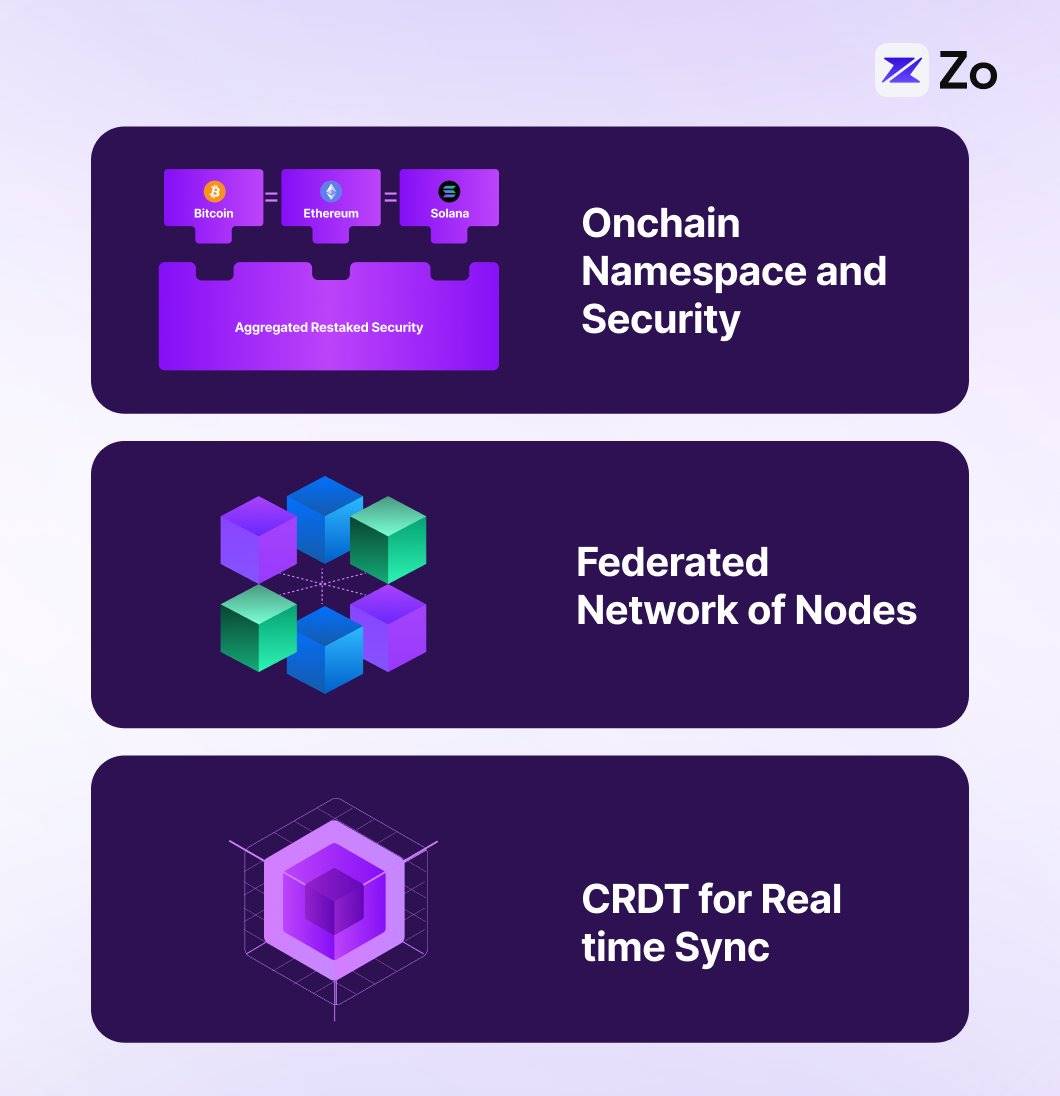
This architecture is naturally suited for federated networks, where autonomous agents operate as independent nodes on devices and implement the Actor model through local edge reasoning. Federated domains can be organized based on the capabilities of agents, with the DHT providing efficient routing and discovery both within and across domains. Each agent operates as an independent actor, possessing its own state, while the CRDT layer ensures consistency across the federation. This multi-layered approach achieves several key functionalities:
Decentralized Coordination
The blockchain is used to provide verifiable identities and a global namespace.
The DHT is used for efficient node discovery and content routing, with lookup times of O(log n).
CRDTs are used for concurrent state synchronization and multi-agent coordination.
Scalable Operations
Region-based federated topology.
Hierarchical storage strategies (hot/warm/cold).
Localized request routing.
Capability-based load distribution.
System Resilience
No single point of failure.
Continuous operation during partitioning.
Automatic state coordination.
Fault-tolerant supervisory hierarchy.
This implementation approach provides a solid foundation for building complex agent systems while maintaining the key attributes of sovereignty, scalability, and resilience required for effective agent interactions.
Final Thoughts
The agent network marks a significant evolution in human-computer interaction, transcending previous incremental developments to establish a new mode of digital existence. Unlike past evolutions that merely changed the way information is consumed or owned, the agent network transforms the internet from a human-centric platform into an intelligent substrate where autonomous agents become the primary participants. This shift is driven by the convergence of edge computing, large language models, and decentralized protocols, creating an ecosystem where personal AI models seamlessly interface with specialized expert systems.
As we move towards an agent-centric future, the boundaries between human and machine intelligence blur, giving way to a symbiotic relationship. In this relationship, personalized AI agents become our digital extensions, capable of understanding our context, anticipating our needs, and autonomously operating within a vast distributed intelligent network. Thus, the agent network represents not just a technological advancement but a fundamental reimagining of human potential in the digital age. In this network, every interaction is an opportunity for augmented intelligence, and every device is a node in a global collaborative AI system.
Just as humans operate in the physical dimensions of space and time, autonomous agents operate in their fundamental dimensions: block space represents their existence, and reasoning time represents their thought. This digital ontology reflects our physical reality—while humans traverse space and experience the flow of time, agents act in the algorithmic world through cryptographic proofs and computational cycles, creating a parallel digital universe.
Operating in a decentralized block space will become an inevitable trend for entities in potential spaces.
免责声明:本文章仅代表作者个人观点,不代表本平台的立场和观点。本文章仅供信息分享,不构成对任何人的任何投资建议。用户与作者之间的任何争议,与本平台无关。如网页中刊载的文章或图片涉及侵权,请提供相关的权利证明和身份证明发送邮件到support@aicoin.com,本平台相关工作人员将会进行核查。




